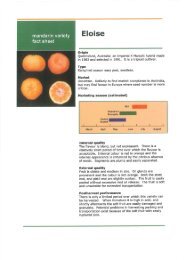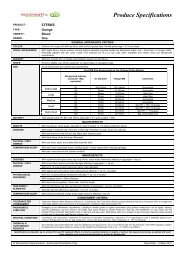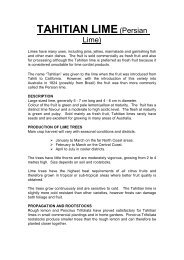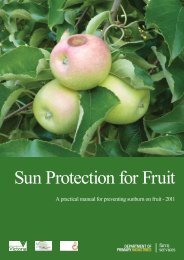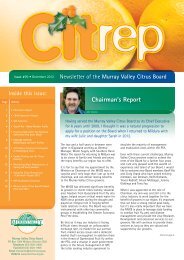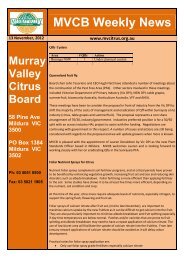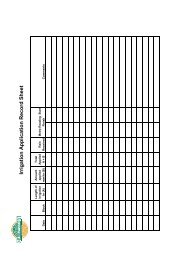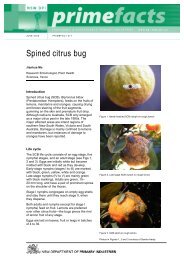100 - South Australian Research and Development Institute - SA ...
100 - South Australian Research and Development Institute - SA ...
100 - South Australian Research and Development Institute - SA ...
Create successful ePaper yourself
Turn your PDF publications into a flip-book with our unique Google optimized e-Paper software.
PACKER NEWSLETTER<br />
Volume 1 Mar 2011<br />
Editor: Peter Taverner<br />
Waite <strong>Research</strong> Precinct<br />
GPO Box 397<br />
Adelaide 5001<br />
Phone 08-83039538<br />
Web Address:<br />
http://www.sardi.sa.gov.au/foodinnovation/publication<br />
s/citrus_packer_newsletter<br />
<strong>100</strong> th Edition of the Packer<br />
Newsletter<br />
Peter Taverner<br />
<strong>SA</strong>RDI<br />
When I wrote my first Packingshed Newsletter (as it was<br />
called then) back in 1997, I never expected that I would<br />
still be writing them now. The first 50 editions were edited<br />
by Kevin Gillespe <strong>and</strong> later Jim Hill, with Barry Tugwell<br />
supplying technical articles through the entire period<br />
(1979-93). It was a great practical resource, which was<br />
modeled on the even greater Florida Packinghouse<br />
newsletter. Barry Tugwell coaxed me into starting the<br />
newsletter again in 1997. I expected to drop it after a few<br />
years as interest waned. Amazingly, we are still here 50<br />
editions later to reach the <strong>100</strong> milestone.<br />
This edition focuses on degreening, which is perennial<br />
favorite topic at this time of the year. I have updated the<br />
degreening article <strong>and</strong> tried to add something new on<br />
m<strong>and</strong>arins. I hope you enjoy the <strong>100</strong> th edition.<br />
INSIDE THIS ISSUE<br />
1 <strong>100</strong> th Edition of the Packer Newsletter<br />
1 Early season degreening <strong>and</strong> associated practices.<br />
4 Degreening m<strong>and</strong>arins: some factors to consider<br />
send me an e-mail :<br />
peter.taverner@sa.gov.au<br />
Early season degreening<br />
<strong>and</strong> associated practices.<br />
Peter Taverner<br />
<strong>SA</strong>RDI<br />
Citrus are non-climacteric fruit, which means that<br />
they do not undergo a defined ripening process, i.e.,<br />
changes are relatively slow. This allows us to harvest<br />
<strong>and</strong> store fruit for reasonably long periods without<br />
significant change to internal quality, but it can make<br />
the decision when to commence harvest difficult <strong>and</strong><br />
arbitrary. Many countries have maturity st<strong>and</strong>ards that<br />
relate to internal taste characteristics, such as sugar<br />
(TSS) <strong>and</strong> acid ratios. As such, the decision to harvest<br />
is based on internal ‘taste’ <strong>and</strong> external appearances<br />
early in the season can be deceiving.<br />
Although immature citrus fruits are green, <strong>and</strong> the<br />
majority of citrus fruit are coloured at marketing, the<br />
internal maturity of citrus fruits cannot be judged by<br />
the external appearance. Citrus fruit grown in hot<br />
humid <strong>and</strong> warms subtropics are green when mature.<br />
The development of colour is promoted by the mild<br />
stress of cold night temperatures (
Continued from page 1<br />
fruit (Wardowski, Miller <strong>and</strong> Grierson 2006). Ethylene<br />
gas can be applied to hasten colouring where ‘natural’<br />
colouring has not coincided with internal maturity. This<br />
process is commonly referred to as ‘degreening’.<br />
There are a number of important considerations to<br />
consider in h<strong>and</strong>ling early season fruit destined for<br />
degreening. They can vary depending on your<br />
geographical <strong>and</strong> climatic conditions, but detailed<br />
instructions for harvesting <strong>and</strong> h<strong>and</strong>ling under <strong>Australian</strong><br />
conditions can be found in the Citrus H<strong>and</strong>ling Guide<br />
(Tugwell 1999).<br />
A summary of the important harvesting considerations is;<br />
Early season Navel oranges must show some<br />
natural colour development prior to degreening<br />
Fruit picked when trees are suffering water<br />
stress tend to wilt <strong>and</strong> lose their calyx during<br />
degreening.<br />
Hot fruit should be allowed to cool to below<br />
27ºC before degreening commences<br />
Fruit intended for degreening should be<br />
harvested with special care to minimize injury<br />
<strong>and</strong> wastage due to later mould development.<br />
Wet, turgid fruit should not be picked because<br />
this fruit is likely to incur rind cell disruption<br />
(Oleocellosis). Oleocellosis spots remain a very<br />
obvious dark green after the degreening process.<br />
Full colour will not develop during degreening if<br />
oil sprays have been recently applied to the trees<br />
prior to harvest.<br />
Bin Drenching<br />
The first fungicide application should be applied to fruit<br />
as soon as possible after harvest, <strong>and</strong> preferably as a bulk<br />
dip or high volume drench in the orchard or on arrival at<br />
the packing facility. Dipping or drenching bins of citrus<br />
with fungicides is undertaken because most injury <strong>and</strong>,<br />
subsequent inoculation of fruit, occurs during harvest.<br />
The general rule is that fungicide treatment should not<br />
exceed 24 hours after harvest or mould development can<br />
occur beyond the point of control (Tugwell 1999).<br />
However, this recommendation is not adequate for all<br />
temperatures <strong>and</strong> fungicide groups (Wild <strong>and</strong> Spohr<br />
1989).<br />
Currently, <strong>Australian</strong> packers use guazatine (for domestic)<br />
<strong>and</strong> thiabendazole (for export) in postharvest dips.<br />
Guazatine has the advantage of controlling moulds <strong>and</strong><br />
sour rot. Thiabendazole (TBZ) doesn’t control sour<br />
rot, but is mixed with sanitisers to control sour rot<br />
spores in solution. Smilinick <strong>and</strong> coworkers showed<br />
combinations of sodium bicarbonate <strong>and</strong> TBZ<br />
were more effective in controlling mould <strong>and</strong> also<br />
did not effect the degreening of oranges (but there<br />
was a slight colour delay in lemons). Our work<br />
suggests that combinations of sodium bicarbonate<br />
<strong>and</strong> TBZ are also quite effective against sour rot.<br />
The rate of sodium bicarbonate with TBZ often 2-<br />
3%, but during degreening is usually lower (at 1%)<br />
to reduce the risk of increased weight loss. Packers<br />
should also add a sanitiser to this combination, but<br />
remember to take into account the pH shift due to<br />
the sodium bicarbonate in solution. The rate may<br />
need to be increased to compensate or consider<br />
using a sanitiser less sensitive to pH.<br />
Fungicide application prior to degreening is<br />
important because degreening provides ideal<br />
conditions for mould development (see ‘ethylene<br />
effects of decay’). Tugwell (1999) suggest that<br />
dipping in fungicide is also useful because<br />
evaporation from wet fruit raises the humidity<br />
within the degreening room. Many packers are<br />
concerned about placing wet fruit into degreening<br />
rooms. There is a risk that free water on the surface<br />
of the fruit will interfere with the ethylene<br />
colouring process. As such, placing wet fruit in the<br />
rooms is a potential problem where humidity is<br />
already very high <strong>and</strong> there is insufficient airflow to<br />
evaporate free water from the fruit’s surface. If<br />
your degreening rooms are already at optimum<br />
humidity &/or you have automated humidity<br />
control, you may be better to leave dipped fruit for<br />
2-3 hours to dry before placing in the room. What<br />
you do depends on your situation, <strong>and</strong> requires<br />
effective monitoring of the conditions in your<br />
degreening rooms.<br />
The calyx can be kept green by dipping in a<br />
solution containing 2,4-D before degreening. The<br />
effect of 2,4-D can vary with cultivar, from useful<br />
extension of button life in navel orange to almost<br />
no effect in degreened Valencia oranges. The best<br />
results are obtained with lemons (Tugwell 1999).<br />
The label for postharvest use on citrus in Australia<br />
is 500ppm, but high rates of 2,4-D ester can inhibit<br />
colouring in sensitive cultivars, such as tangelos. In<br />
some countries, much lower rates are used on easy<br />
Continued on page 3<br />
<strong>South</strong> <strong>Australian</strong> <strong>Research</strong> <strong>and</strong> <strong>Development</strong> <strong>Institute</strong> Packer Newsletter No.<strong>100</strong>, page 2
Continued from page 2<br />
peel cultivars prior to degreening (see article below on<br />
degreening m<strong>and</strong>arins).<br />
Sorting<br />
The sorting of fruit into colour groups prior to<br />
degreening is highly desirable since each colour group<br />
can be degreened for the optimum period. Wardowski<br />
et. al. (2006) found that colour sorting actually increases<br />
the efficiency of degreening <strong>and</strong> reduces decay. This is<br />
because more fruit can be degreened in the same facility<br />
by removing well-coloured fruit <strong>and</strong> shortening the<br />
degreening time for lots with greater colour break. The<br />
advancement of automated colour sorting equipment<br />
<strong>and</strong> computer monitoring of degreening rooms allows<br />
this approach to be cost-effective.<br />
Degreening process<br />
Many citrus cultivars can be quite palatable while their<br />
peel colour is still green. The consumer associate green<br />
with immaturity <strong>and</strong> the use of ethylene to ‘degreen’ is a<br />
legitimate method to improve the visual quality of,<br />
otherwise, mature fruit.<br />
Ethylene effects on citrus colouring<br />
Ethylene is a natural growth regulator produced by most<br />
fruits as a response to stress or during the natural<br />
ripening process. Ethylene does not ripen citrus fruits.<br />
As such, the acid, sugars <strong>and</strong> flavour of the juice are<br />
unaffected by ethylene exposure. However, ethylene<br />
does destroy chlorophyll, <strong>and</strong> promote the development<br />
of yellow <strong>and</strong> orange carotenoids in the flavedo (Stewart<br />
<strong>and</strong> Wheaton 1972). Under conditions of mild stress,<br />
such as cold nights, citrus degreen naturally. The<br />
postharvest use of ethylene seeks to chemically hasten<br />
the degreening process.<br />
Ethylene effects on decay<br />
Ethylene promotes senescence (aging), which increases<br />
the susceptibility of citrus to decay. The temperature<br />
(typically, 22º to 24º C) <strong>and</strong> high humidity (ideally, 95%<br />
RH) required for ethylene degreening also provides ideal<br />
conditions for the development of postharvest disease.<br />
Ethylene accelerates senescence of the fruit calyx, which<br />
favours ‘stem-end rots’ (eg. Diplodia natalensis, Phomopsis<br />
citri <strong>and</strong> Alternaria citri). Ethylene also plays a role in the<br />
induction of anthracnose decay (Colletotrichum<br />
gloeosporiodes). The level of ethylene used in degreening is<br />
considered important. Ethylene levels above 5 ppm do<br />
not hasten degreening or improve colour, but may cause<br />
serious loses from anthracnose disease. Exogenous<br />
ethylene causes germination of the appresorria to begin<br />
the infection process, but ethylene can also induce<br />
physiological changes required for the development of<br />
fruit resistance. The role of ethylene in anthracnose<br />
development is complex, <strong>and</strong> well described by<br />
Timmer <strong>and</strong> Brown (2000).<br />
Degreening practices<br />
Citrus fruit require some colour break prior to harvest<br />
for effective degreening. The harvested fruit are<br />
usually treated with a fungicide prior to placing in<br />
degreening rooms or under plastic tents. The ‘trickle’<br />
method is a common method to apply ethylene. This<br />
involves continually replacing the air in the degreening<br />
area with a low concentration of ethylene.<br />
Traditionally, the concentration of ethylene is usually<br />
around 5ppm, <strong>and</strong> should seldom exceed 10ppm.<br />
However, it has long been recognised that 1ppm is<br />
adequate (Grierson 2004). The development of<br />
sophisticated monitoring systems means we can deliver<br />
a consistent lower dose, with rates of >1.5ppm used<br />
successfully in commercial citrus degreening rooms.<br />
Efficient airflow <strong>and</strong> ventilation facilitates uniform<br />
distribution of the ethylene <strong>and</strong> removes accumulated<br />
carbon dioxide. If you can measure CO2<br />
concentrations; the concentration should remain below<br />
0.3%. If you can’t measure CO2, the common air<br />
ventilation recommendation of one room volume per<br />
hour is usually successful, but is related to good room<br />
design <strong>and</strong> automated humidity control (Wardowski et.<br />
al. 2006). The most undesirable effect of degreening<br />
under low humidity is fruit softening, <strong>and</strong> exacerbation<br />
of injuries <strong>and</strong> rind weaknesses.<br />
Each growing region must determine its own optimum<br />
degreening conditions, especially temperature range. In<br />
Australia, a uniform temperature of between 20ºC <strong>and</strong><br />
25ºC for oranges <strong>and</strong> up to 30ºC lemons is considered<br />
ideal for colour development (Tugwell 1999).<br />
Humidity should be above 80% while heating fruit <strong>and</strong><br />
above 90% when up to uniform temperature.<br />
Maintaining above 95% RH is difficult without<br />
automatic controls, but the ‘up-front’ cost may be well<br />
worth it.<br />
Grierson (2004) described how degreening Temples<br />
(tangors) caused an ugly peel injury that disappeared<br />
when conditions remained above 85% RH. He also<br />
conducted a study on fruit shrinkage at 85% <strong>and</strong> 95%<br />
to demonstrate the value of automatic humidity<br />
Continued on page 4<br />
<strong>South</strong> <strong>Australian</strong> <strong>Research</strong> <strong>and</strong> <strong>Development</strong> <strong>Institute</strong> Packer Newsletter No.<strong>100</strong>, page 3
Continued from page 3<br />
control. 95% RH resulted in 2% more fruit to sell,<br />
which could pay for the instrumentation in one season.<br />
Ethylene phytotoxicity<br />
Excess rates of ethylene may produce rind damage or<br />
‘gas burn’. Some citrus cultivars are more sensitive to<br />
ethylene damage. To reduce the risk to sensitive<br />
varieties, such as ‘Fallglo’ tangerines, fruit can be<br />
allowed to ‘degas’ after ethylene treatment <strong>and</strong> prior to<br />
waxing. Alternatively, fruit can be exposed to ethylene<br />
for shorter periods (6-12 hours) before transferring into<br />
high humidity rooms (without ethylene) until<br />
acceptable colour development. (Petracek et. al 2006).<br />
Ethylene can increase the susceptibility of fruit to<br />
anthracnose (caused by Colletrichum gloesporioides) <strong>and</strong> the<br />
symptoms of this disease can be misdiagnosed as<br />
ethylene damage unless carefully examined.<br />
References<br />
Grierson W. (2004) Early Degreening <strong>Research</strong>:<br />
Establishing Basic Principles. Proc. Fla. State Hort. Soc. 117,<br />
348-350.<br />
Petricek P.D. Kelsey D.F. <strong>and</strong> Grierson W. (2006)<br />
Physiological peel disorders. pp. 374-419. In Fresh Citrus<br />
Fruits.Wardowski W. F., Miller W. M., Hall D. J. <strong>and</strong><br />
Grierson W. (Editors) Florida Science Source, Florida, U<strong>SA</strong>.<br />
Smilanick JL. Mansour M.F. <strong>and</strong> Sorenson D. 2006 Pre-<br />
<strong>and</strong> Postharvest Treatments to Control Green Mould of Citrus<br />
Fruit During Ethylene Degreening. Plant Disease. 90 (1): 89-<br />
96<br />
Stewart, I. And Wheaton, T.A. (1972) Carotenoids in<br />
citrus, their accumulation induced by ethylene. J. Agr. Food<br />
Chem. 20, 448-449.<br />
Timmer L. M. <strong>and</strong> Brown G E. (2000) Biology <strong>and</strong><br />
control of anthracnose diseases in citrus, pp. 300-316. In<br />
Colletotrichum: host specificity, pathology <strong>and</strong> host-pathogen<br />
interaction, Pruski D., Freemen S. <strong>and</strong> Dickman M. B. (Eds)<br />
APS Press, St. Paul, Minnosota, U<strong>SA</strong>.<br />
Tugwell B. 1999. Citrus H<strong>and</strong>ling Guide. <strong>South</strong><br />
<strong>Australian</strong> <strong>Research</strong> <strong>and</strong> <strong>Development</strong> <strong>Institute</strong>, Adelaide,<br />
Australia. ISBN No. 0 7308 5245 8.<br />
Wardowski W.F., Miller W.M. <strong>and</strong> Grierson W. (2006)<br />
Degreening pp. 227-298. In Fresh Citrus Fruits. Wardowski<br />
W. F., Miller W. M., Hall D. J. <strong>and</strong> Grierson W. (Editors)<br />
Florida Science Source, Florida, U<strong>SA</strong>.<br />
Wild B. L. <strong>and</strong> Spohr L. J. 1989. Influence of fruit<br />
temperature <strong>and</strong> application time on the effectiveness of fungicides<br />
in controlling citrus green mould, Penicillium digitatum. Aust. J.<br />
Exp. Agr. 29, 139-142.<br />
Reprint from Newsletter 90 (2008) after minor<br />
revision.<br />
Degreening m<strong>and</strong>arins:<br />
some factors to consider<br />
Peter Taverner<br />
<strong>SA</strong>RDI<br />
During the last decade, there has been a continuous<br />
rise in the dem<strong>and</strong> for, <strong>and</strong> consumption of, easy to<br />
peel m<strong>and</strong>arin varieties. For counties like Australia to<br />
benefit, this means shipping fresh fruit considerable<br />
distances to the more populous Northern<br />
hemisphere. Unfortunately, m<strong>and</strong>arins are more<br />
perishable than other citrus <strong>and</strong> the longer transport<br />
times pose increased challenges to maintaining fruit<br />
quality.<br />
I have largely ignored this trend, but intend to ‘get up<br />
with the times’ <strong>and</strong> consider m<strong>and</strong>arins specifically. In<br />
regard to degreening m<strong>and</strong>arins, <strong>Australian</strong> packers<br />
have adapted information from overseas <strong>and</strong> learnt by<br />
trial <strong>and</strong> error. I don’t have a lot of direct experience,<br />
but offer the following distillation of overseas<br />
information.<br />
Temperature<br />
The optimum temperature for degreening will depend<br />
on a number of factors, including the local climate<br />
<strong>and</strong> the initial color of the fruit. Florida has<br />
maintained a fairly high degreening temperature of<br />
29ºC for citrus. Mediterranean-type climate countries<br />
have reduced temperatures, with temperatures of 20-<br />
25ºC commonly cited. However, a recent paper by<br />
Tietal <strong>and</strong> coworkers (2010) suggest that in the last<br />
few years it has become common in Spain to degreen<br />
Satsuma <strong>and</strong> other early m<strong>and</strong>arin varieties at 18-<br />
22ºC. A <strong>South</strong> African study (Terblanche 1999)<br />
comparing degreening of Satsumas at 18ºC <strong>and</strong> 24ºC<br />
gives some insights into the potential advantages <strong>and</strong><br />
disadvantages of reducing temperature. He found an<br />
interesting effect; the higher temperature resulted in<br />
darker orange colour, but more fruit changed colour<br />
at the lower temperature. He suggested that fruit<br />
should have some colour break on tree before<br />
degreening, to colour sort before degreening <strong>and</strong> then<br />
manage the degreening process accordingly.<br />
Continued on page 5<br />
<strong>South</strong> <strong>Australian</strong> <strong>Research</strong> <strong>and</strong> <strong>Development</strong> <strong>Institute</strong> Packer Newsletter No.<strong>100</strong>, page 4
Taste<br />
Continued from page 4<br />
Ethylene degreening may have an adverse effect of<br />
internal quality, resulting in off flavours. However, Tietel<br />
<strong>and</strong> coworkers found that degreening early season<br />
Satsuma m<strong>and</strong>arins (3-5 days; 4 ppm ethylene at 20ºC)<br />
maintained quality. They also integrated a curing period<br />
into the degreening process (3-5 days; 4 ppm ethylene at<br />
30ºC). [ Hang on! We have gone full circle back to Bill<br />
Grierson’s original Florida recommendation?] Yes! This is<br />
reverting to earlier higher temperatures, but selectively.<br />
Early season fruit can be slow to reduce acid to palatable<br />
levels. Burdon <strong>and</strong> coworkers (2007) showed that short<br />
periods of conditioning at 30ºC can reduce acid levels <strong>and</strong>,<br />
thereby, improve taste (e.g., TSS:Acid ratio from 6.7 to 9.4<br />
after curing). However, it is only useful early in the season<br />
to reduce high acid to optimum maturity thresholds.<br />
Reducing acid in already internally mature fruit may make<br />
them taste insipid. Unfortunately, curing can also lead to<br />
higher weight loss <strong>and</strong>, subsequently, a shorter shelf life.<br />
As such, this is probably a strategy for early season<br />
domestic marketing <strong>and</strong> not for long overseas voyages.<br />
Calyx Retention<br />
The synthetic auxin 2,4-D has long been used as a<br />
postharvest treatment to delay calyx drying <strong>and</strong> browning<br />
that occurs as a consequence of degreening. The label<br />
rate in Australia remains high relative to rates used<br />
overseas, especially for m<strong>and</strong>arins. Carvalho <strong>and</strong><br />
coworkers (2008) treated four Clementine varieties with<br />
either 5 or 10ppm 2,4-D ester before degreening <strong>and</strong><br />
found low amounts of calyx browning at 10ppm <strong>and</strong><br />
5ppm for Clemenules <strong>and</strong> Clemenpons, respectively. The<br />
other 2 varieties, Marisol <strong>and</strong> Oronules, are both much<br />
more susceptible to browning <strong>and</strong> abscission. These rates<br />
were not sufficient to keep a high proportion of their<br />
calyces in acceptable condition. The 2,4-D used did delay<br />
colouring, but all fruit reached acceptable colour 7 days<br />
after degreening commenced. The fruit were under 2ppm<br />
ethylene, 95% RH <strong>and</strong> 21 o C for either 3 days (for yelloworange<br />
fruit) or 4 days (for green-yellow fruit). The<br />
Note: Articles are the best information available to<br />
the author at publication. Mention of a pesticide or a<br />
commercial or propriety product does not constitute<br />
an endorsement or recommendation of its use. The<br />
<strong>South</strong> <strong>Australian</strong> <strong>Research</strong> <strong>and</strong> <strong>Development</strong><br />
<strong>Institute</strong> (<strong>SA</strong>RDI) makes no warranty of any kind<br />
expressed or implied concerning the use of<br />
technology mentioned in this document.<br />
overall message is that the success of treatments can<br />
vary depending on the cultivars <strong>and</strong> initial colour, but<br />
there still appears to be considerable scope to explore<br />
the use of lower 2,4-D rates for m<strong>and</strong>arins.<br />
This work was instigated because the European Union<br />
has restricted the postharvest use of 2,4-D. It is still an<br />
acceptable treatment in a number of countries, including<br />
Australia. However, it seems appropriate to look at ways<br />
to lower rates <strong>and</strong> find replacement treatments.<br />
References<br />
Carvalho C.P. Salvador A. Navarro P. Monterde A. amd<br />
Martinez-Javega J.M. (2008) Effect of Auxin Treatments on<br />
Calyx Senescence in the Degreening of Four M<strong>and</strong>arin Cultivars.<br />
HortScience. 43 (3): 747-752.<br />
Grierson W. (2004) Early Degreening <strong>Research</strong>:<br />
Establishing Basic Principles. Proc. Fla. State Hort. Soc. 117,<br />
348-350.<br />
Terblanche E. (1999) Effect of Temperature on the Colour of<br />
citrus during Degreening. A<strong>SA</strong>E meeting presentation paper no.<br />
996120. Downloaded on 03/03/2011 at :<br />
http://www.docstoc.com/docs/20234974/EFFECT-<br />
OF-TEMPERATURE-ON-THE-COL<br />
Petricek P.D. Kelsey D.F. <strong>and</strong> Grierson W. (2006)<br />
Physiological peel disorders. pp. 374-419. In Fresh Citrus<br />
Fruits.Wardowski W. F., Miller W. M., Hall D. J. <strong>and</strong><br />
Grierson W. (Editors) Florida Science Source, Florida, U<strong>SA</strong>.<br />
Acknowledgements<br />
This program has been facilitated by HAL in partnership<br />
with Citrus Australia. It has been funded by voluntary<br />
contributions from two regional marketing boards for the<br />
period of June–Dec 2010. The <strong>Australian</strong> Government<br />
provides matched funding for all HAL’s R&D activities.<br />
<strong>South</strong> <strong>Australian</strong> <strong>Research</strong> <strong>and</strong> <strong>Development</strong> <strong>Institute</strong> Packer Newsletter No.<strong>100</strong>, page 5




